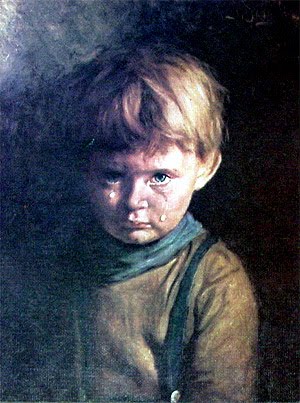The Weeping Boy Painting
The legend around this painting is as grim as it gets. The stories began around 1985, when several mysterious fires occurred all around England. When the debris was sifted through the only item that remained un-charred was a painting of a little boy with a tear rolling his cheek in every fire. Could this all be coincidence?
Whether real or not a Yorkshire fireman was so upset that he talked with the “Sun” newspaper in England. They ran his story about how everything in the home was consumed by fire except for a painting of a crying boy. There were at that time more than one of these paintings around and each seemed to have the same effect. The home and all contents would be totally destroyed but the painting of the little crying boy would not show any sign at all of going through a fire. The newspaper began receiving telephone calls from people all over the area that had similar stories to tell about the crying boy painting. One person that called the “Sun” was Dora Mann of Mitcham and she has been quoted as saying "Only six months after I had bought the picture, my house was completely gutted by fire. All my paintings were destroyed, except the one of the crying boy." After one month of hearing all the tales, the “Sun” gave their readers the chance to bring their crying boy paintings and agreed to have a very large bon fire to rid everyone of this cursed or jinxed painting. All paintings that were brought to the newspaper were in fact burned and everyone rejoiced.

However, the story goes on. There have been reports of the crying boy painting being found in charred homes untouched since 1985 and as recent as 1988.
No one knows for sure who the artists might be and where he got the idea to paint a portrait of a crying boy, the rumors are many and the tale is still around. The fact is beware if you find a beautiful painting of a sad, little crying boy.
‘The Curse of the Crying Boy’ appeared out of the blue one morning in 1985. The Sun, at that time the most popular tabloid newspaper in the English-speaking world, published on page 13 of its 4 September edition a story headlined: “Blazing Curse of the Crying Boy”. It told how Ron and May Hall blamed a cheap painting of a toddler with tears rolling down his face for a fire which gutted their terraced council home in Rotherham, a mining town in South Yorkshire. The blaze broke out in a chip-pan in the kitchen of their home of 27 years and spread rapidly. But although the downstairs rooms of the house were badly damaged, the framed print of the Crying Boy escaped unscathed. It continued to hang there, surrounded by a scene of devastation.
Normally a chip-pan blaze would merit nothing more than a couple of paragraphs in a local newspaper. What transformed this story into a page lead in Britain’s leading tabloid was the intervention of Ron Hall’s brother Peter, a firefighter based in Rotherham. A colleague of Peter’s, station officer Alan Wilkinson, said he knew of numerous other cases where prints of the ‘Crying Boy’ had turned up, undamaged, in the ruins of homes destroyed by fires. Accompanying the article was a photograph of a ‘Crying Boy’, with the caption: “Tears for fears… the portrait that firemen claim is cursed.”
The firemen concerned had not actually used the word ‘cursed’, but nevertheless the newspaper report had helped to give the story a certain level of credibility. The paper added that an estimated 50,000 ‘Crying Boy’ prints, signed ‘G Bragolin’, had been sold in branches of British department stores, particularly in the working class areas of northern England. Examples could be seen hanging in the front rooms of family homes across the nation, and one story even suggested a quarter of a million had been sold.
After one month of hearing all the tales, the “Sun” gave their readers the chance to bring their “Crying boy” paintings and agreed to have a very large bon fire to rid everyone of this cursed or jinxed painting. All paintings that were brought to the newspaper were in fact burned and everyone rejoiced. However, the story goes on. There have been reports of the crying boy painting being found in charred homes untouched since 1985 and as recent as 1988.
Typical of these additional stories was that told by Dora Mann, from Mitcham, Surrey, who claimed her house was gutted just six months after she bought a print of the painting. “All my paintings were destroyed – except the one of the Crying Boy,” she claimed. Sandra Kaske, of Kilburn, North Yorkshire, said that she, her sister-in-law, and a friend had all suffered disastrous fires since they acquired copies. Another family, from Nottingham, blamed the print for a blaze which had left them homeless. Brian Parks, whose wife and three children needed treatment for smoke inhalation, said he had destroyed his copy after returning from hospital to find it hanging – undamaged, of course – on the blackened wall of his living room. As the stories accumulated, new details emerged that encouraged the idea that possession of a print put owners at risk of fire or serious injury.
One woman from London claimed she had seen her print “swing from side to side” on the wall, while another from Paignton said her 11-year-old son had “caught his private parts on a hook” after she bought the picture. Mrs Rose Farrington of Preston, in a letter published by The Sun, wrote: “Since I bought it in 1959, my three sons and my husband have all died. I’ve often wondered if it had a curse.”
Rotherham fire station officer Alan Wilkinson who had personally logged 50 ‘Crying Boy’ fires dating back to 1973, dismissed any connection with the supernatural, having satisfied himself that most of them had been caused by human carelessness. But despite his pragmatism, he could not explain how the prints had survived infernos which generated heat sufficient to strip plaster from walls. His wife had her own theory: “I always say it’s the tears that put the fire out.” The Sun was not interested in finding a rational explanation. It ignored Wilkinson’s comments and claimed “fire chiefs have admitted they have no logical explanation for a number of recent incidents.”
Soon afterwards, it emerged that the ‘cursed’ prints were not all copies of the same painting, nor were all the prints by the same artist. The picture that survived the fire in Rotherham that initially triggered the scare was signed by the artist G Bragolin. The Sun claimed the original was “by an Italian artist”. In fact, Giovanni Bragolin was a pseudonym adopted by Spanish painter Bruno Amadio, who is also known as ‘Franchot Seville’.
The story was uncovered by “a well respected researcher into occult matters, a retired schoolmaster from Devon named George Mallory” in 1995. Mallory traced the artist who had painted the original, “an old Spanish portrait artist named Franchot Seville, who lives in Madrid”. Seville, as astute readers will recognise, was one of the pseudonyms used by Bruno Amadio, otherwise known as ‘G Bragolin’ whose signature appeared on some of the prints.
Seville/Amadio/Bragolin told Mallory the subject of the paintings was a little street urchin he had found wandering around Madrid in 1969. He never spoke, and had a very sorrowful look in his eyes. Seville painted the boy, and a Catholic priest identified him as Don Bonillo, a child who had run away after seeing his parents die in a blaze. “The priest told the artist to have nothing to do with the runaway, because wherever he settled, fires of unknown origin would mysteriously break out; the villagers called him ‘Diablo’ because of this.” Nevertheless, the painter ignored the priest’s advice and adopted the boy. His portraits sold well but one day his studio was destroyed by fire and the artist was ruined. He accused the little boy of arson and Bonillo ran off – naturally in tears – and was never seen again. From all over Europe came the reports of the unlucky Crying Boy paintings causing blazes. Seville was also regarded as a jinx, and no one commissioned him to paint, or would even look at his paintings.
In 1976, a car exploded into a fireball on the outskirts of Barcelona after crashing into a wall. The victim was charred beyond recognition, but part of the victim’s driving license in the glove compartment was only partly burned. The name on the license was one 19-year-old Don Bonillo.” Psychics claimed the boy's spirit was trapped in the painting and that the curse extends to all the many different versions of the painting!
The curse apparently only affects those who are aware that the painting is cursed - hardly surprising since any subsequent misfortune will get blamed on the painting. Some Crying Boy paintings had a companion Crying Girl or a painting of a boy and girl holding flowers. About the only thing the various prints had in common was that they were cheap, mass-produced paintings sold by department stores in the 1960s and 1970s and popular in working class homes .... where they hung uneventfully until 1985, or so it seems.


Comments
Post a Comment